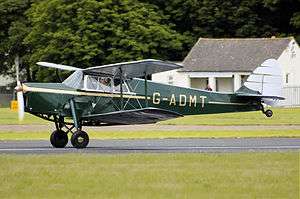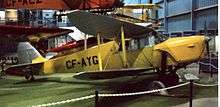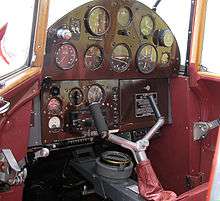de Havilland Hornet Moth
The de Havilland DH.87 Hornet Moth is a single-engined cabin biplane designed by the de Havilland Aircraft Company in 1934 as a potential replacement for its highly successful de Havilland Tiger Moth trainer. Although its side-by-side two-seat cabin made it closer in configuration to the modern aircraft that military trainee pilots would later fly, there was no interest from the RAF and the aircraft was put into production for private buyers.
| DH.87 Hornet Moth | |
|---|---|
 | |
| 1936 de Havilland DH.87B Hornet Moth | |
| Role | Trainer and Tourer |
| Manufacturer | de Havilland |
| First flight | 9 May 1934 |
| Status | still in operation |
| Primary user | private owner pilots |
| Produced | 1935–1938 |
| Number built | 164 |
Design and development

The prototype first flew at Hatfield on 9 May 1934 and, with two other pre-production aircraft, embarked on an extensive test program that resulted in the first production aircraft (designated DH.87A) completed in August 1935 having wings of greater outboard taper. These were found to cause problems, especially when landing in three-point attitude: there was a tendency for the tips to stall, causing embarrassment to the pilot and often damage to the aeroplane. From early 1936, de Havilland offered owners of the DH.87A replacement wings of the new squarer shape at a reduced price in exchange for the original wings. Designated DH.87B, new aircraft from about manufacture Number 68 were built with the new square wings. This wing reduced the overall span by 8 inches (20 cm). The alterations slightly increased overall weight at some penalty to performance.
Production was 164 aircraft, of which 84 were placed on the British Register. Many were impressed for military service during World War II, mostly being used by the RAF as liaison aircraft.
Small numbers survived the war and with time became highly prized by vintage aircraft enthusiasts. A small number are still flying, over seventy years after production ceased.
Variants

_at_Cotswold_Airport_29Sept2018_arp.jpg)
- DH.87 Hornet Moth : prototypes
- DH.87A Hornet Moth : production model
- DH.87B Hornet Moth : production model with wing modification
Operators
Civil charter operators and pilots 1935–2009
Military operators
- Royal Air Force (1940–1945)
- Royal Navy Fleet Air Arm
- One aircraft impressed and four from Canada
Specifications (DH.87B)

Data from Jane's All the World's Aircraft 1938,[2] De Havilland Aircraft since 1909 [3]
General characteristics
- Crew: 1
- Capacity: 1 passenger / trainee
- Length: 24 ft 11.5 in (7.607 m)
- Wingspan: 31 ft 11 in (9.73 m)
- Height: 6 ft 7 in (2.01 m)
- Wing area: 244.5 sq ft (22.71 m2)
- Airfoil: RAF 15[4]
- Empty weight: 1,241 lb (563 kg)
- Gross weight: 1,950 lb (885 kg)
- Fuel capacity: 35 imp gal (42 US gal; 159 l) fuel in fuselage tank ; 2 imp gal (2 US gal; 9 l) oil in an air-cooled tank
- Powerplant: 1 × de Havilland Gipsy Major I 4-cylinder air-cooled inverted in-line piston engine, 130 hp (97 kW)
- Propellers: 2-bladed fixed-pitch propeller
Performance
- Maximum speed: 124 mph (200 km/h, 108 kn) at sea level
- Cruise speed: 105 mph (169 km/h, 91 kn) at 1,000 ft (305 m)
- Stall speed: 40 mph (64 km/h, 35 kn)
- Range: 620 mi (1,000 km, 540 nmi)
- Service ceiling: 14,800 ft (4,500 m)
- Rate of climb: 690 ft/min (3.5 m/s)
- Time to altitude: 5,000 ft (1,524 m) in 8 minutes 45 seconds
- Wing loading: 7.97 lb/sq ft (38.9 kg/m2)
- Power/mass: 0.067 hp/lb (0.110 kW/kg)
References
Notes
- Hitler's Savage Canary by David Lampe ISBN 978-1-84832-574-6 pg15
- Grey, C.G.; Bridgman, Leonard, eds. (1938). Jane's All the World's Aircraft 1938. London: Sampson Low, Marston & company, ltd. p. 31c.
- Jackson 1987, p.355.
- Lednicer, David. "The Incomplete Guide to Airfoil Usage". m-selig.ae.illinois.edu. Retrieved 16 April 2019.
Bibliography
- Jackson, A.J. De Havilland Aircraft since 1909. London: Putnam, Third edition, 1987. ISBN 0-85177-802-X.
- Follett, K. "Hornet flight", (translated in Italian "Il volo del calabrone", Mondadori Editore S.p.A., Milano, 2003 ISBN 88-04-54428-7) It's a fictitious novel, first printed in 2002, in which a hornet moth plays a key role in the story.
External links
| Wikimedia Commons has media related to De Havilland DH.87 Hornet Moth. |